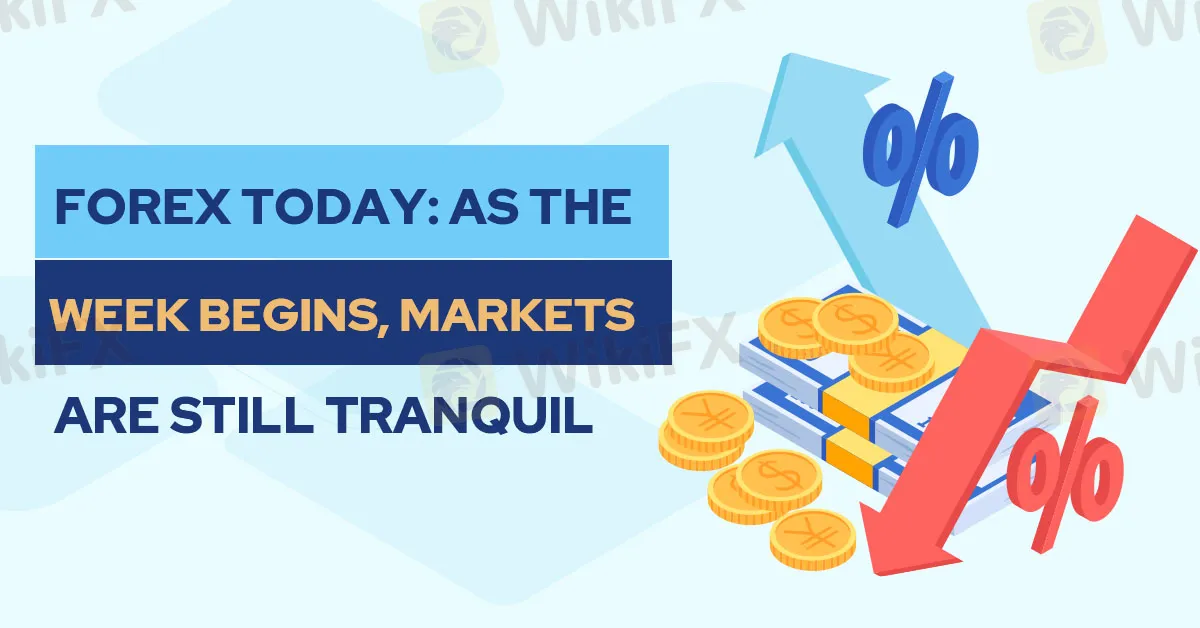简体中文
繁體中文
English
Pусский
日本語
ภาษาไทย
Tiếng Việt
Bahasa Indonesia
Español
हिन्दी
Filippiiniläinen
Français
Deutsch
Português
Türkçe
한국어
العربية
FOREX TODAY: AS THE WEEK BEGINS, MARKETS ARE STILL TRANQUIL.
Abstract:Early on Monday, major currency pairings trade within well-known ranges as investors remain cautious ahead of the major macroeconomic events of the week. There won't be any major data releases on the economic calendar. The Bank of Japan (BoJ) will make its monetary policy announcements during the Asian session on Tuesday, while the Bundesbank of Germany will deliver its monthly report during European trading hours.

WHAT YOU NEED KNOW ON MONDAY, JANUARY 22 IS AS FOLLOWS:
Early on Monday, major currency pairings trade within well-known ranges as investors remain cautious ahead of the major macroeconomic events of the week. There won't be any major data releases on the economic calendar. The Bank of Japan (BoJ) will make its monetary policy announcements during the Asian session on Tuesday, while the Bundesbank of Germany will deliver its monthly report during European trading hours.
After rising by almost 1% the week before, the US Dollar (USD) Index moves in a narrow trend above 103.00, while the yield on the benchmark 10-year US Treasury note remains above 4%. In the meantime, futures for the US stock index are starting the week slightly higher.
THE CURRENT US DOLLAR PRICE
The US dollar's (USD) percentage change compared to a list of major currencies is displayed in the table below. The US dollar underperformed the euro the most.
| USD | EUR | GBP | CAD | AUD | JPY | NZD | CHF | |
| USD | -0.12% | -0.11% | 0.05% | 0.16% | -0.03% | 0.21% | 0.00% | |
| EUR | 0.11% | 0.00% | 0.16% | 0.26% | 0.07% | 0.32% | 0.12% | |
| GBP | 0.10% | -0.02% | 0.14% | 0.26% | 0.07% | 0.32% | 0.10% | |
| CAD | -0.05% | -0.15% | -0.14% | 0.13% | -0.06% | 0.18% | -0.03% | |
| AUD | -0.17% | -0.28% | -0.28% | -0.11% | -0.20% | 0.05% | -0.15% | |
| JPY | 0.03% | -0.08% | -0.02% | 0.08% | 0.22% | 0.26% | 0.03% | |
| NZD | -0.21% | -0.33% | -0.32% | -0.18% | -0.05% | -0.25% | -0.21% | |
| CHF | 0.00% | -0.12% | -0.11% | 0.03% | 0.14% | -0.05% | 0.19% |
The major currencies' percentage movements relative to one another are displayed on the heat map. The quotation currency is selected from the top row, and the base currency is selected from the left column. For example, the percentage change shown in the box will indicate EUR (base)/JPY (quote) if you select the Euro from the left column and proceed along the horizontal line to the Japanese Yen.
The broad-based rise of the USD put pressure on EUR/USD, which ended the week lower. President of the European Central Bank (ECB) Christine Lagarde made a statement at the World Economic Forum (WEF) in Davos on Friday. She did not address the forecast for monetary policy in the near term, but she did point out that inflation was declining both globally and in the Eurozone. The pair stays steady at 1.0900 early on Monday.
On Friday, the USD/JPY reached its highest level since late November at 148.80, but it quickly gave up those gains, closing the day flat at just over 148.00. In a narrow channel, the pair moves up and down in proximity to the weekly closing level.
“If the BoJ makes it clear that it does not intend to change its expansionary course for the time being – which we believe is likely – USD/JPY could rise a little further,” Commerzbank analysts said, providing a preview of the possible impact of the BoJ event on the pair.
Following a week of slight losses, GBP/USD appears to have entered a consolidation period on Monday, trading around roughly 1.2700. The next significant data releases from the UK will be the Services and Manufacturing PMIs on Wednesday.
Even if Gold gained on Thursday and Friday, it still dropped by almost 1% the week before. XAU/USD continues to decline early on Monday; at $2,020, it had lost almost 0.5% of its value thus far.
For the third straight week, the Australian dollar fell against the US dollar, and on Monday it traded in a narrow range below 0.6600 during the Asian session. On Tuesday, National Australia Bank will make available data for December on business conditions and business confidence.

Disclaimer:
The views in this article only represent the author's personal views, and do not constitute investment advice on this platform. This platform does not guarantee the accuracy, completeness and timeliness of the information in the article, and will not be liable for any loss caused by the use of or reliance on the information in the article.
Read more

WikiEXPO Dubai “Welcome Party” Concludes Successfully, Setting the Stage for the Main Event!
On the evening of November 10, 2025, the highly anticipated WikiEXPO Dubai “Welcome Party” was successfully held at the 6th Floor, Conrad Dubai, UAE. Serving as a “prelude” to the official opening of the expo, this event provided a high-end yet relaxed communication platform for representatives of global regulatory bodies, leaders of Fintech companies, renowned brokers, and senior executives of investment institutions.

VARIANSE Review: Traders Raise Deposit & Withdrawal Issues and High Commission & Swap Charges
Are you losing both while depositing and withdrawing your capital at VARIANSE? Does the broker give the currency conversion rate excuse for this? Have you been trapped with spreads charged higher than promised? Do you bear steep commission and swap charges at this broker? Traders frequently report these trading issues online. In today’s VARIANSE broker review, we have shared some trading complaints that have grabbed everyone’s attention. Take a look.

Zetradex Exposed: Withdrawal Denials, Account Freeze & Bonus Issues Hurt Traders
Do you constantly face withdrawal denials by Zetradex? Does the forex broker keep freezing your account and wiping out your capital? Have you also undergone issues concerning the Zetradex no deposit bonus? These trading issues have become apparent as the forex broker allegedly scams traders all over. In this Zetradex review article, we have demonstrated some complaints. Read them to get a feel of what happens to traders here.

Fullerton Markets Review: Traders Allege Profit Wipes and Illegitimate Withdrawal Rates
Have you witnessed constant profit deletion from Fullerton Markets? Has the Saint Vincent and the Grenadines-based forex broker wiped out all your capital after you checked it on Fullerton Markets Login? Do you find the deposit and withdrawal rates abnormal here? These complaints have been grabbing everyone’s attention on Fullerton Markets Review Platforms. In this article, we have shared some of these complaints for you to look at and inspect. Read on!
WikiFX Broker
Latest News
BASF CEO: EU CO₂ Trading Is A "Destruction Mechanism" For European Industry
Is Fyntura a Regulated Broker? A Complete 2025 Broker Review
Zetradex Exposed: Withdrawal Denials, Account Freeze & Bonus Issues Hurt Traders
Is Forex Zone Trading Regulated and Licensed?
PINAKINE Broker India Review 2025: A Complete Guide to Safety and Services
Exness Restricted Countries List 2025 Explained
Is Uniglobe Markets Legit? A 2025 Simple Guide to Its Safety, Services, and User Warnings
Is Inzo Broker Safe or a Scam? An Evidence-Based Analysis for Traders
WikiEXPO Dubai 2025 “Welcome Party” Kicks Off Tonight!
He Trusted a WhatsApp Group and Lost RM659,000
Currency Calculator



